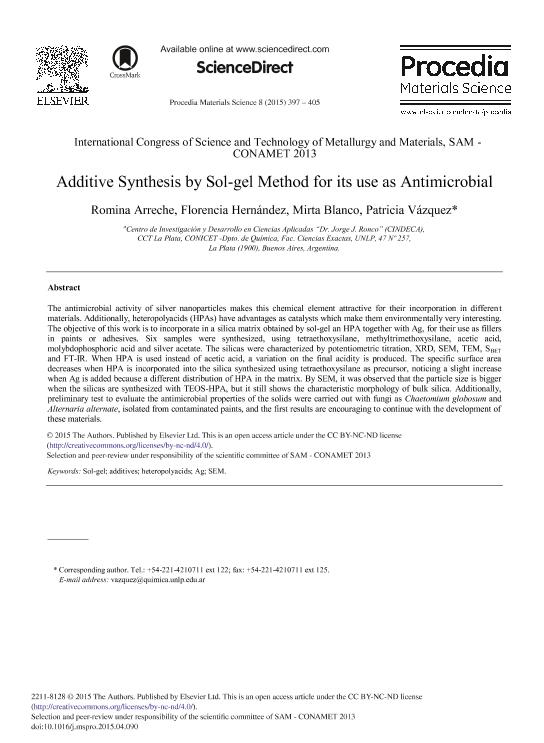Mostrar el registro sencillo del ítem
dc.contributor.author
Arreche, Romina

dc.contributor.author
Hernández, Maria Florencia

dc.contributor.author
Blanco, Mirta Noemi

dc.contributor.author
Vazquez, Patricia Graciela

dc.date.available
2018-03-21T21:23:04Z
dc.date.issued
2015-06
dc.identifier.citation
Arreche, Romina; Hernández, Maria Florencia; Blanco, Mirta Noemi; Vazquez, Patricia Graciela; Additive synthesis by sol-gel method for its use as antimicrobial; Elsevier; Procedia Materials Science; 8; 6-2015; 397-405
dc.identifier.issn
2211-8128
dc.identifier.uri
http://hdl.handle.net/11336/39575
dc.description.abstract
The antimicrobial activity of silver nanoparticles makes this chemical element attractive for their incorporation in different materials. Additionally, heteropolyacids (HPAs) have advantages as catalysts which make them environmentally very interesting. The objective of this work is to incorporate in a silica matrix obtained by sol-gel an HPA together with Ag, for their use as fillers in paints or adhesives. Six samples were synthesized, using tetraethoxysilane, methyltrimethoxysilane, acetic acid, molybdophosphoric acid and silver acetate. The silicas were characterized by potentiometric titration, XRD, SEM, TEM, SBET and FT-IR. When HPA is used instead of acetic acid, a variation on the final acidity is produced. The specific surface area decreases when HPA is incorporated into the silica synthesized using tetraethoxysilane as precursor, noticing a slight increase when Ag is added because a different distribution of HPA in the matrix. By SEM, it was observed that the particle size is bigger when the silicas are synthesized with TEOS-HPA, but it still shows the characteristic morphology of bulk silica. Additionally, preliminary test to evaluate the antimicrobial properties of the solids were carried out with fungi as Chaetomium globosum and Alternaria alternate, isolated from contaminated paints, and the first results are encouraging to continue with the development of these materials.
dc.format
application/pdf
dc.language.iso
eng
dc.publisher
Elsevier

dc.rights
info:eu-repo/semantics/openAccess
dc.rights.uri
https://creativecommons.org/licenses/by-nc-nd/2.5/ar/
dc.subject
Sol-Gel
dc.subject
Additives
dc.subject
Heteropolyacids
dc.subject
Ag
dc.subject.classification
Recubrimientos y Películas

dc.subject.classification
Ingeniería de los Materiales

dc.subject.classification
INGENIERÍAS Y TECNOLOGÍAS

dc.title
Additive synthesis by sol-gel method for its use as antimicrobial
dc.type
info:eu-repo/semantics/article
dc.type
info:ar-repo/semantics/artículo
dc.type
info:eu-repo/semantics/publishedVersion
dc.date.updated
2018-03-05T20:44:57Z
dc.journal.volume
8
dc.journal.pagination
397-405
dc.journal.pais
Países Bajos

dc.journal.ciudad
Amsterdam
dc.description.fil
Fil: Arreche, Romina. Consejo Nacional de Investigaciones Científicas y Técnicas. Centro Científico Tecnológico Conicet - La Plata. Centro de Investigación y Desarrollo en Ciencias Aplicadas ; Argentina
dc.description.fil
Fil: Hernández, Maria Florencia. Consejo Nacional de Investigaciones Científicas y Técnicas. Centro Científico Tecnológico Conicet - La Plata. Centro de Investigación y Desarrollo en Ciencias Aplicadas ; Argentina
dc.description.fil
Fil: Blanco, Mirta Noemi. Consejo Nacional de Investigaciones Científicas y Técnicas. Centro Científico Tecnológico Conicet - La Plata. Centro de Investigación y Desarrollo en Ciencias Aplicadas ; Argentina
dc.description.fil
Fil: Vazquez, Patricia Graciela. Consejo Nacional de Investigaciones Científicas y Técnicas. Centro Científico Tecnológico Conicet - La Plata. Centro de Investigación y Desarrollo en Ciencias Aplicadas ; Argentina
dc.journal.title
Procedia Materials Science
dc.relation.alternativeid
info:eu-repo/semantics/altIdentifier/doi/http://dx.doi.org/10.1016/j.mspro.2015.04.090
dc.relation.alternativeid
info:eu-repo/semantics/altIdentifier/url/https://www.sciencedirect.com/science/article/pii/S2211812815000917
Archivos asociados
